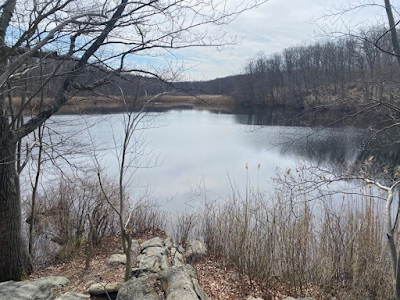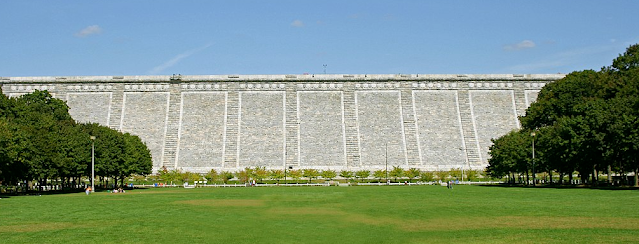Went for a walk last week to the Cranberry Lake Preserve in Valhalla, Westchester County. It's a 190 acre biodiversity preserve with some hiking trails (a horribly-designed set of hiking trails, by the way, with the same color blaze used for completely different trails - without a map in hand you'd easily go astray). Of course Cranberry Lake Preserve surrounds, not surprisingly, the pretty Cranberry Lake.
Of interest to us, however, is an abandoned quarry built to supply stone for the nearby Kensico Dam - part of the New York City water supply system - which was completed in 1917.
Walking the trails from the parking lot reveals what appears to be the Fordham Gneiss (the g is silent and gneiss is pronounced "nice"). Fordham Gneiss is a high-grade metamorphic rock formed during the Grenville orogeny (an orogeny is a mountain building event) a bit over a billion years ago. It was formed from high temperature and pressure alteration of sediments and volcanic material (probably associated with a volcanic island arc) caught up in a massive collision between proto-North American (called Laurentia) and, we think, a block of crust called Amazonia. This collision formed Himalayan-scale mountains right here on what was an ancient supercontinent called Rodinia (hundreds of millions of years prior to the later supercontinent of Pangaea).
This gneiss, that we walk on today, was once miles below the surface of those ancient Grenville Mountains only exposed today after a billion years of erosion!
The quarry that supplied rock for the Kensico Dam is on the other side of the lake from the parking area. A few of the pits were filled with water and supposedly once used as swimming holes by the locals.
The rock they were quarrying here was not the Fordham Gneiss, however, it was the Yonkers Gneiss. You might think gneiss is gneiss, but that's not the case. The Yonkers Gneiss is what's called a granitic gneiss meaning it formed from the metamorphism of the igneous rock granite (as opposed to the Fordham Gneiss which formed from sediments and volcanic material). The Yonkers Gneiss is quite attractive (even more so when cut and polished) and was valued as a building stone (in the building trade, it's sometimes called the Yonkers granite but that's geologically incorrect).
Even if you don't care about the geological mysteries here, it is a nice hike. In mid-March it's easier to see the geology without all the green stuff, mosquitos were still absent, and we were serenaded by a chorus of wood frogs and spring peepers.









No comments:
Post a Comment